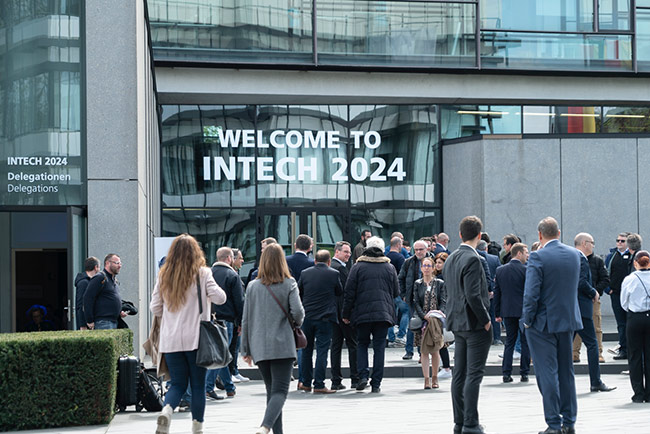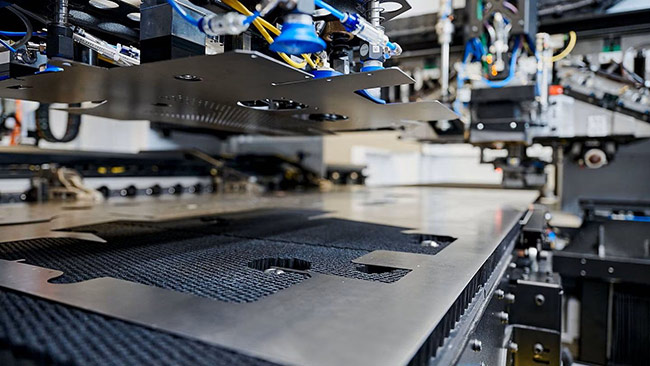ANDREAS THOSS, CONTRIBUTING EDITOR
INTECH, the annual in-house trade show of laser pioneer TRUMPF, is always an impressive event. This year, TRUMPF was prepared to welcome 3000 guests — many of them customers — to its Ditzingen, Germany premises, the site of the company’s global headquarters. When Intech started on April 9, the company made sure that all machines in the vast halls of TRUMPF’s application center were staffed with the appropriate technology experts, primed and ready to speak with the visitors. While showing around several dozen members of press, Manuel Thomae, who heads international media relations, at TRUMPF, said that the firm has the largest number of laser systems worldwide available for testing in its application center.

Laser systems manufacturer TRUMPF expected 3000 guests at its inhouse trade fair, INTECH, earlier this month. The company made AI a major focus of the four-day event. Courtesy of Andreas Thoss.
For a visitor, the trip to the small town 30 minutes north of Stuttgart Airport also makes sense; the four-day trade fair will often extend far beyond the offerings of a typical industry show. All visitors see real machines produce real parts. Guests can even bring their own parts and see what the machines can do.
Compared to its presence at such a trade show, the investment similarly appears to provide good value for the company: Visitors are focused, with no competitor booths commanding attention. It is fair to wonder how commercial trade show organizers view this event.
What is AI in production?
TRUMPF has been a technology driver for decades. It was one of the first to develop a laser for manufacturing, an early adopter of metal 3D printing, and today its laser for extreme ultraviolet generation is instrumental to the world’s finest lithography system.
It was only a matter of time before TRUMPF would adopt a technology like artificial intelligence (AI).
TRUMPF supplied a four-page fact sheet on AI to members of the press at INTECH. This was somewhat unusual, but appropriate for such a new technology. Still, it didn’t serve a rather obvious question: Will ChatGPT, the world’s most prominent AI software make it to the shop floor? Probably not, since ChatGPT is a large language model. And AI in production is rarely about language.
What TRUMPF’s attention to AI revealed instead ultimately became visible in several examples that were shown at the press conference and during the subsequent tours at INTECH.
The first example is very intriguing. Imagine an engineer attending to a 3-axis milling machine. This fairly experienced engineer would listen to the back-and-forth movement of the gantry and be able to tell you if the machine is working well or if there is an issue. This function is exactly what Trumpf’s AI does. The company has attached a microphone to its 3-axis machines and allows the gantry to move in a predefined path in all directions. If there is a loose connection, or even just a nut laying in the machine, the AI will detect the irregularity.
TRUMPF uses this system for the final assembly of its machines, Stephan Mayer, CEO TRUMPF Machine Tools said. The AI listens to the sound of the machine and tells the human controller if something is wrong. If a screw is not properly tightened, or, worse, if it is missing, the AI hears the defect.
This explanation came with a surprise: “It was shocking to see that in every 100 machines, something was missing,” Mayer said in his press conference. TRUMPF fixed the inconsistency and in fact decided to leave the AI microphone mechanism in the machine. Now, a customer can turn it on and send the recording to TRUMPF, which can then analyze the problem without sending a human engineer for to service the equipment. It is safe to say that AI has become a tool in this field.
Image processing, construction support, and more
A major application of AI in production relates to analyzing sensor data. Acoustic sensors are rare — some may find this surprising — with optical sensors finding more widespread use for industrial data acquisition. For example, Trumpf offers an AI-based software that supports hairpin welding for electromotors. Two-hundred such hairpins are required to be joined for an average motor and a TRUMPF laser handles 1000 motors per day. The software recognizes the copper pin pairs in a black and white image. The pins are located in different places within the image and shifted to each other. The software finds them and defines the trajectory to weld them.
The actual welding takes 100 to 300 ms. The role of the AI software is to help to achieve a ‘first-time-right’ result, according to TRUMPF.

TRUMPF’s “Runability Guide” will check, for example, how much a part will buckle as a result of gravitational force during removal, and thereby possibly causing the process to jam. If a predefined limit value is exceeded, the software marks the corresponding area in red. Users can see immediately which parts of a job require attention. Courtesy of Andreas Thoss via TRUMPF.
In TRUMPF’s VCSEL diode production, an AI-based vision system helps to identify contaminations on semiconductors early in the process. The system can identify laser chips that may be defective long before it is possible to run the actual lasing test. Chips can be phased out and expensive processing and testing steps can be avoided. A similar function takes place in welding machines, where the AI can be used to distinguish good and bad weld seems.
But AI can do much more than quality control. At Intech, TRUMPF presented a software tool, “iAssist,” that aims to support engineers optimize parts design. If, for example, a steel holder is made of three joined components, the tool may suggest a solution where the holder is made from one piece of steel with some bended parts instead of attached components.
Yet another AI tool has been designed to help users with workflow optimization. This “Runnability Guide” analyzes the jobs on a flatbed machine and gives the operator suggestions for which jobs could run overnight and which should have an operator around to oversee performance, since manual intervention is determined to be expected in such cases.
These are only a few simple tools that TRUMPF presented at the fair. AI makes it possible to compile expert know-how into software and let the software continue to learn, or be trained on new data sets. TRUMPF has invested in digital technologies for years, and these tools now fit well into its strategic engagements.
For a wider future, TRUMPF could consider selling entire manufacturing lines with remotely controlled processes. It could then offer manufacturing as a service rather than selling machines for manufacturing.
Worried about AI in production?
One hundred years ago, engine driven machines replaced horses. Tractors, lorries, and cars changed the world. Yes, jobs moved from one place to another. But nobody sees a problem in that a car runs faster than a human or a horse. Why should we worry if a machine separates good welds from bad welds faster than a human? It is a just another machine that takes over from the prior cast of workers. And, it can gather experience from hundreds of samples and use this data to make a decision that would otherwise require a qualified human who may be better-deployed in another setting. AI works around the clock without getting tired and learns from the job it has been assigned as long as we properly tell it to. AI will increase productivity, help to drive down rejected and deficient components, and save on costs, energy, and precious materials.
As for our jobs — they’ll just change. Again.
In the meantime, think about the possibilities arriving soon as well as in the distant future. One day, your machine might even have a voice interface using a large language model to talk to you. It’s a funny thing to think about, but there are much more important features coming. Controlling complete machines and processes is a major consideration and area of focus in industry. Since detecting problems in a machine or process is one thing, changing settings to get it back on track, is another, and much more complex task. So far, this requires an experienced operator. Even experts do not dare to say when AI will be good enough to close the control loop and manage complete machines and processes.
As such, this is the next big thing that we wait for.